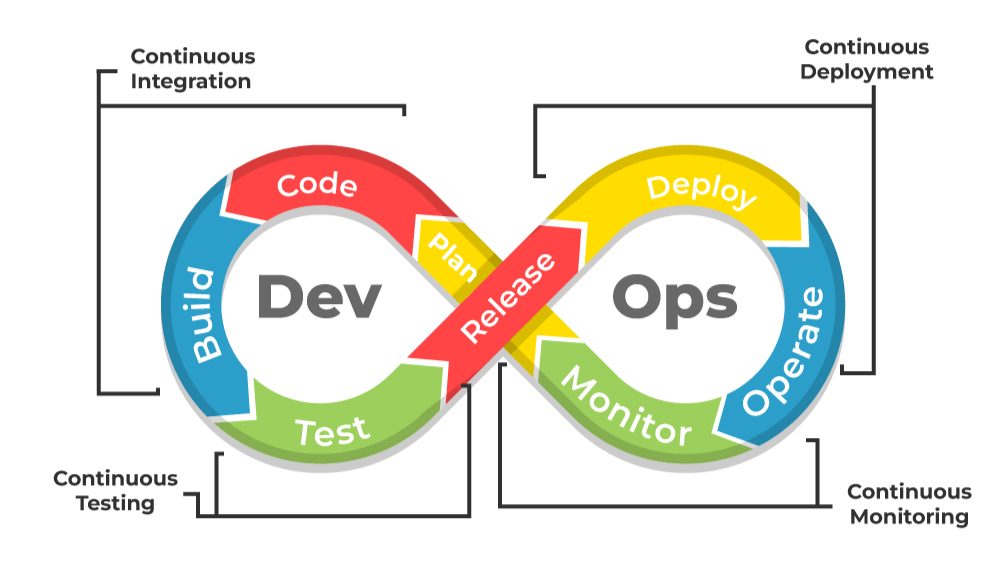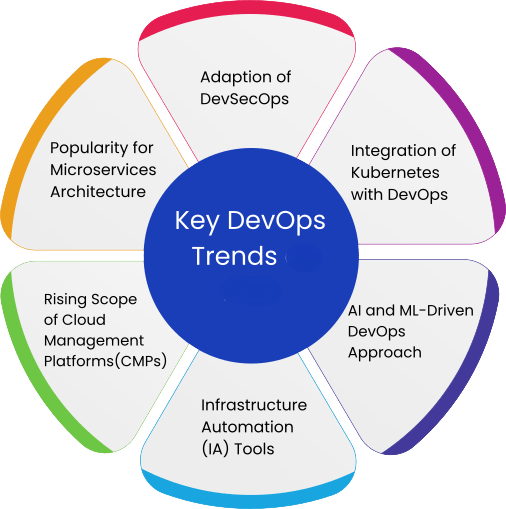
- Introduction to DevOps
- Current Trends in DevOps
- Automation and AI in DevOps
- The Role of Cloud Platforms in DevOps Evolution
- DevOps in the Age of Microservices
- Scaling DevOps in Large Enterprises
- Predictions for the Future of DevOps
- Conclusion
Introduction to DevOps
DevOps is a modern approach to software development and IT operations that focuses on collaboration, automation, and continuous delivery. It bridges the gap between development and operations teams, enabling faster and more efficient software deployment. By integrating automation tools, Infrastructure as Code (IaC), and continuous integration/continuous deployment (CI/CD) pipelines, DevOps streamlines workflows, reduces errors, and enhances software quality. In today’s rapidly evolving tech landscape, DevOps is shifting towards greater automation, scalability, and security with the rise of AI, machine learning, and DevSecOps, concepts that are thoroughly explored in the Devops Course. Organizations are adopting DevOps to accelerate software delivery, improve system reliability, and ensure seamless user experiences. Concepts like GitOps, cloud-native development, and containerization further enhance DevOps efficiency. With a strong emphasis on collaboration and monitoring, DevOps enables businesses to innovate quickly while maintaining stability. As the demand for agile and resilient software solutions grows, DevOps continues to be a critical methodology for modern software engineering.
To Earn Your Cloud Computing Certification, Gain Insights From Leading Cloud Computing Experts And Advance Your Career With ACTE’s Devops Online Training Today!
Current Trends in DevOps
DevOps is continually evolving, with new tools, practices, and philosophies emerging to address the ever-changing demands of the software development and IT operations landscape. Today, the trend in DevOps is shifting towards greater automation, scalability, and collaboration. Organizations are increasingly adopting DevOps to enhance collaboration between development and operations teams, reduce deployment time, improve software quality, and ensure a seamless experience for end-users.
- Automation Everywhere: Automation remains the backbone of DevOps. Continuous integration (CI), continuous delivery (CD), automated testing, and infrastructure automation are becoming standard practices in DevOps pipelines.
- Increased Adoption of Microservices: The move toward microservices architectures is reshaping how organizations develop and deploy software, with DevOps practices adapting to handle the complexities of microservices.
- AI and Machine Learning: The integration of AI and machine learning into DevOps processes is gaining momentum. These technologies are used to predict potential failures, automate decision-making, and enhance testing processes, as outlined in the Ultimate Guide to Installing Git on Windows for streamlined version control and collaboration.

- Security-First Approach (DevSecOps): As security becomes increasingly critical, DevOps is evolving into DevSecOps, where security practices are integrated into every stage of the software development lifecycle.
- Containerization and Orchestration: Docker, Kubernetes, and other container technologies are accelerating software delivery and improving scalability, enabling better management of microservices environments.
- Collaboration and Communication: With DevOps emphasizing collaboration, tools that facilitate communication, such as Slack, Jira, and Microsoft Teams, have become integral to DevOps workflows.
- Serverless Computing: Serverless computing allows developers to focus on code without worrying about infrastructure, contributing to faster deployment cycles and reduced operational overhead.
Automation and AI in DevOps
Automation and AI are key drivers in the evolution of DevOps, offering organizations a means to streamline workflows, minimize manual effort, and enhance decision-making. These technologies enable DevOps teams to focus on high-priority tasks while ensuring consistency and reliability across the development and operations pipeline. Automation is at the core of DevOps, particularly in areas such as CI/CD, testing, deployment, and infrastructure management. It ensures that processes are repeatable, reducing human error and accelerating the time-to-market for new features and updates. Continuous Integration and Delivery tools like Jenkins, GitLab CI, and CircleCI automate the integration of new code and its delivery to production, enabling frequent releases while maintaining stability, with a deeper understanding of the Key Differences in Git Rebase vs. Git Merge essential for managing code changes effectively. Automated testing tools such as Selenium, JUnit, and TestNG play a critical role in ensuring new code doesn’t introduce bugs, automating unit, integration, and UI tests to enhance software quality. Infrastructure Automation through Infrastructure as Code (IaC) tools like Terraform and Ansible automates the creation, configuration, and management of infrastructure, making it scalable and repeatable. Automated monitoring tools like Prometheus, Grafana, and Datadog provide real-time monitoring and alerting, enabling teams to detect issues before they impact users and ensuring optimal software performance. AI is revolutionizing DevOps by offering predictive analytics, smarter automation, and enhanced decision-making.
Are You Interested in Learning More About Devops? Sign Up For Our Devops Online Training Today!
The Role of Cloud Platforms in DevOps Evolution
Cloud platforms are integral to the growth and success of DevOps. They provide the flexibility, scalability, and reliability required for continuous development and delivery of software. Cloud computing offers several advantages, such as easy access to virtualized resources, faster provisioning, and the ability to scale infrastructure on-demand.
- Scalability and Flexibility: Cloud platforms like Amazon Web Services (AWS), Microsoft Azure, and Google Cloud Platform (GCP) provide on-demand compute resources, enabling organizations to scale up or down based on workload demands. This flexibility is essential for implementing DevOps practices like CI/CD, where infrastructure needs can change frequently.
- Infrastructure as a Service (IaaS): IaaS platforms allow DevOps teams to manage infrastructure without worrying about the underlying hardware. This abstraction simplifies the deployment of applications and services, as the infrastructure is handled by the cloud provider.
- Containerization and Orchestration: Cloud platforms support containerization technologies like Docker and orchestration tools like Kubernetes, making it easier to deploy, scale, and manage containerized applications across multiple environments, while also helping developers to Resolve Merge Conflicts in Git efficiently.
- Automated Scaling and Load Balancing: Cloud environments support auto-scaling and load balancing, allowing applications to automatically adjust based on incoming traffic. This is essential for ensuring that applications perform well under varying load conditions.
- Collaboration and Continuous Integration: Cloud-based DevOps tools like GitHub, GitLab, and Bitbucket allow teams to collaborate on code, track changes, and automate testing and deployment. Cloud environments enable real-time collaboration, making it easier for distributed teams to work together. Cloud platforms have revolutionized DevOps by providing the necessary infrastructure, tools, and services that enable rapid development, testing, and deployment.
DevOps in the Age of Microservices
The rise of microservices has significantly impacted the DevOps landscape. Microservices architecture involves breaking down applications into smaller, independent services that can be developed, tested, and deployed individually, which enhances agility, scalability, and fault tolerance. However, it also introduces new challenges for DevOps teams. One major impact is decentralization, as microservices require decentralized development and deployment processes. Each service can be independently developed, tested, and deployed, aligning well with DevOps practices like continuous integration and delivery. Managing a large number of microservices can be complex, but tools like Docker, Kubernetes, and automated deployment help teams manage this complexity, as covered in the Devops Course. Continuous delivery is another advantage, as microservices can be deployed independently without affecting the entire application, enabling faster delivery cycles and quicker updates. With many microservices running in production, monitoring becomes critical. Tools such as Prometheus, ELK Stack, and Grafana assist DevOps teams in ensuring the optimal performance of individual microservices. Additionally, microservices improve fault tolerance, as the failure of one service does not affect the entire application. Continuous monitoring, testing, and automated failover practices help ensure the resilience of microservices in production. Overall, microservices and DevOps are highly complementary, with DevOps practices enabling the automation and orchestration necessary to manage microservices effectively at scale.
Are You Considering Pursuing a Cloud Computing Master’s Degree? Enroll For Devops Masters Course Today!
Scaling DevOps in Large Enterprises
While DevOps offers significant benefits in terms of speed and quality, scaling DevOps practices in large enterprises can be challenging. Large organizations often have complex infrastructures, numerous teams, and legacy systems that need to be integrated into the DevOps pipeline.
- Cultural Resistance: Large enterprises often face cultural resistance to change. DevOps requires a shift in mindset and collaboration across teams that may have traditionally worked in silos.
- Legacy Systems Integration: Legacy systems can be difficult to integrate with modern DevOps practices. However, enterprises are increasingly adopting DevOps practices incrementally, beginning with new projects or specific teams, and gradually integrating legacy systems over time.
- Toolchain Complexity: Large organizations require a comprehensive toolchain that spans multiple stages of the DevOps lifecycle, with Load Balancing playing a crucial role in ensuring high availability and distribution of traffic across applications. Managing and integrating these tools can be complex, but solutions like GitLab, Jenkins, and Kubernetes offer ways to unify workflows.
- Governance and Compliance: Enterprises must balance the need for speed with governance, compliance, and security requirements. Automating compliance checks and integrating them into CI/CD pipelines is essential for maintaining regulatory standards.
- Start Small and Scale Gradually: Begin by implementing DevOps in small, manageable teams or projects. As teams mature, scale DevOps practices across the organization, integrating more systems and departments.
- Invest in Automation: Automation is crucial for scaling DevOps in large enterprises. Automating testing, deployment, infrastructure provisioning, and monitoring can significantly reduce the complexity of managing large systems.
- Standardize Processes and Tools: Standardizing tools, practices, and workflows across teams helps maintain consistency and reduces friction when scaling DevOps across the organization.
Predictions for the Future of DevOps
The future of DevOps is promising, shaped by continuous innovation and the emergence of new technologies. A significant trend will be the increased adoption of AI and machine learning, which will automate decision-making, predictive analytics, and anomaly detection within DevOps processes. Additionally, serverless computing and edge technologies will drive the decentralization of development and deployment, enabling DevOps teams to focus more on building and scaling applications, with an Understanding Dockerfile Purpose & Key Concepts being essential for containerizing applications effectively. Security will remain a core focus, with DevSecOps practices ensuring security is integrated throughout the DevOps lifecycle rather than treated as an afterthought.

The rise of AIOps will further enhance operational efficiency by automating tasks using machine learning, helping DevOps teams address performance issues and operational challenges more effectively. Moreover, the wider adoption of low-code/no-code platforms will accelerate application development, requiring DevOps teams to automate deployment and integration to keep pace. As DevOps continues to evolve, it will lead to faster, more efficient, and secure software development practices.
Preparing for Cloud Computing Job Interviews? Have a Look at Our Blog on Devops Interview Questions & Answer To Ace Your Interview!
Conclusion
In conclusion, DevOps is rapidly evolving to meet the growing demands of modern software development and IT operations. With a strong focus on automation, scalability, and collaboration, organizations are leveraging DevOps to accelerate deployment cycles, enhance software quality, and ensure seamless user experiences. The integration of AI and machine learning is streamlining processes, while Infrastructure as Code (IaC) is enabling efficient infrastructure management. Additionally, GitOps is improving version control and automation, and DevSecOps is reinforcing security throughout the development lifecycle, all of which are key topics discussed in the Devops Course. These advancements are fostering a culture of continuous improvement, enabling businesses to innovate faster while maintaining stability and security. As enterprises increasingly prioritize agility and efficiency, DevOps will remain an essential strategy for bridging the gap between development and operations. By embracing evolving tools and best practices, organizations can stay ahead in the competitive digital landscape, ensuring resilience, reliability, and long-term success in their software delivery processes.





